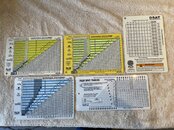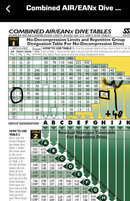In post #63 I gave the specifics of two dives I did in Cozumel in June. I will repeat those dive profiles below. I have two questions for you.I'm glad I was taught the tables, even though most of my dive buddies have computers I still reference the tables, get a planned depth and set my watch on a countdown of that max depth and max time for a plan. Only problem with that is I don't have as much bottom time as I could going to a couple different depths but I could get a laminated tables or something to bring with me if I was concerned about that. Right now I'm more concerned about building my skills better.
- How much time would your tables have given you on those two dives?
- You said, "Only problem with that is I don't have as much bottom time as I could going to a couple different depths but I could get a laminated tables or something to bring with me if I was concerned about that." Could you explain how having laminated tables with you on the dive would change that?
These dives were done using EANx 32. Both were NDL dives--no required decompression.
Dive One
Maximum depth = 126 feet
Total dive time = 83 minutes
Surface Interval = 91 minutes
Dive Two
Maximum DEpth = 88 feet
Total dive time = 92 minutes





